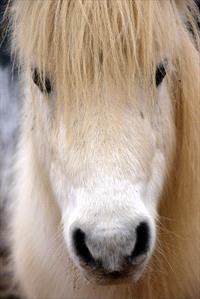Every spring it got worse. 'Seriously!' I glared at my horse, spitting out a mouthful of fuzz and looking at the drifts of horse hair in the pen. 'I could make a pony out of all of this!'
Face of White Horse

Every spring it got worse. “Seriously!” I glared at my horse, spitting out a mouthful of fuzz and looking at the drifts of horse hair in the pen. “I could make a pony out of all of this!”
Owners of older horses first notice the ridiculous amounts of winter hair – you can’t NOT notice it; it’s long, curly and gets EVERYWHERE. Next, they find that spring (aka shedding season) comes later and later. Toward the end of Goldie’s life (in her mid-30s), full shedding didn’t happen until roughly August, and even then, there were often random pale blond tufts on her otherwise sleek, golden summer coat – sort of like horse barnacles.
Beyond the nuisance factor, hairiness or hirsutism (think “hair suit”), is a sign of a common metabolic disorder in older horses.
Pituitary Pars Intermedia Disorder (PPID), commonly called Cushings disease (no, not Cushion Disease), affects roughly a quarter of horses over age 15.
While hirsutism is the most easily recognizable sign, Cushings does more to the horse than just create more hair to sweep up.
The pituitary gland (in the brain) produces a hormone (adrenocorticotropic hormone or ACTH) that signals to the adrenal gland to produce cortisol (a stress hormone). In the normal system, once cortisol production has reached a certain level, it waves a flag at the adrenal saying “Okay, hold up! We’re good here.” In PPID horses, abnormal tissue in the pituitary refuses to listen to the signaler and keeps yelling at the adrenals “MORE CORTISOL! MORE! MORE!”
Horses with PPID can develop a raft of problems beyond imitating wooly mammoths. Recognizable outward signs include redistribution of fat and atrophy (wasting) of muscle. This is where you start to get the pot-bellied, sway-backed old horse look. They may also show behavioral changes such as becoming less active, moving more stiffly, and urinating or drinking more than usual.
Other, less obvious signs are also more dangerous. PPID can cause laminitis (laminitis) and make horses more prone to sole abscesses. These horses also become more susceptible to other infections since the constant adrenal activity slows down the immune system. They can also develop suspensory ligament breakdown where their fetlocks droop like flowers in my garden and try to kiss the ground. The outcome for horses with suspensory breakdown isn’t any better than the prognosis for any flower I plant.
Since hirsutism isn’t always the first indication of Cushing’s disease, if your horse is over the age of about 12 and develops laminitis, sole abscesses, or unexplained lameness or infections, your veterinarian might recommend testing for PPID.
The “gold standard” test traditionally has been a dexamethasone suppression test. This test requires taking two blood samples a set period of time apart with a dose of dexamethasone (a corticosteroid that the body recognizes sort of like cortisol) shortly after the first blood draw. In a normal horse, the dexamethasone will signal to the pituitary that there is enough cortisol and shut down ACTH production. In a horse with PPID, as we can guess, the pituitary ignores the dexamethasone and goes blithely on, flooding the body with ACTH.
However, a simpler test is more commonly used nowadays. Your veterinarian can draw blood and have the laboratory measure the ACTH level in a single blood draw. We now have reference ranges for normal horses compared to horses with PPID. Even though horses have naturally changing ACTH levels in different seasons, most labs now adjust their reference ranges to account for those fluctuations.
The most effective treatment for Cushing’s disease -- in addition to managing diet and maintaining good preventative care such as vaccination, hoof care, dentistry, and parasite control – is a drug called pergolide. Pergolide helps (we don’t know exactly how) to calm the exuberance of the wayward pituitary gland in PPID horses.
It is important to realize that like many things along the treatment highway , pergolide is a treatment, not a cure. Once a horse has Cushing’s disease, it has it for life and will need to be managed for life.
That life doesn’t necessarily need to be a short one. Goldie produced enough hair to field a flock of ponies, but she lived about 15 more years after she started imitating a polar bear in winter, passing peacefully in a spring green orchard at age 36.